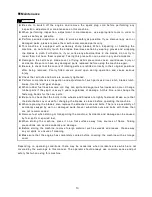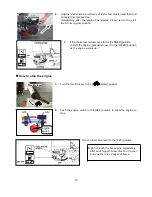
22
How to load and unload using a truck
Park the truck on a flat and stable surface. Switch off the
truck’s engine, engage reverse gear, and pull
the parking brake. Also place chucks under the
truck’s wheels to stop it from moving.
Before loading or unloading, raise the height of the blades so that they will not contact the ramp. There
is a danger of the blades catching on the ramp, possibly causing the machine to roll over.
Attach the ramp’s hook so that there is no bump where it attaches to the truck’s loading bed. Also
make sure that the ramp is securely attached.
Use caution
when the machine crosses from the ramp to the truck’s loading bed and the location of the
center of gravity is suddenly changed.
Do not stand on the front of the machine.
Do not operate any of the machine’s levers while on the ramp as there is a danger of the machine
rolling over.
Make sure that the rubber crawler tracks on either side of the machine are positioned centrally on the
ramp.
When loading and transportin
g by truck, engage the machine’s parking break and secure the machine
in the loading bed with a rope that is sufficiently strong enough. Also place chucks under the machine’s
wheels to stop it from moving.
How to load and unload
1.
Park your vehicle on a flat surface with no dangerous objects
nearby.
2.
Attach a ramp which conforms to the standards below.
3.
Put the throttle lever in the intermediate position between
[ (HI)] and [ (LOW)].
4.
Only load the machine in forward gear [1] and only unload in
reverse [R]. Do not use any other gear.
Ref: Ramp standards
Make sure that your ramp is comprised of materials strong enough to conform to the following standards.
Length:
3.5 times longer than the truck’s loading bed is high.
Width:
At least as wide as the wheel span of the machine.
Strength:
Sufficiently strong enough to take the weight of the sum total of the
machine and the operator.
Surface:
Use a ramp with a non-slip surface.
Use of side clutch is
strictly prohibited.
















































